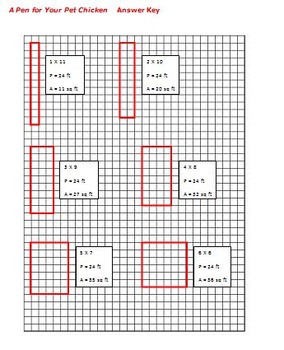

If they struggle with this, have them create equations before they even start with the rods:

So they could make a right triangle, or they could create a rectangle with a triangle in it.)Īfter they are understanding that, it is time to increase the difficulty. What is the perimeter? What is the area? (If this is appropriate for your children, you may have to remind them that they have to know the height.


Yet in this example, because the rods are not overlapping, the child has made a rectangle that is 5 by 4:ĭepending on the needs of your kiddos, you may want to start off with the very basics. In this example, the child has made a rectangle that is 4 by 3: It is important to state here that you can actually get different areas and perimeters, even while using the same rods. Next, the children need some time to explore area and perimeter with the rods. It may even be helpful to create a chart as a “cheat” sheet. Now it is easy to see that the white equals one, the red two, the light green three and so on. Now it is time for some math, and a good place to start is with the value of each rod.īegin by having them line up the rods in order from shortest to tallest. Second, even if they are just playing with them, they are making observations and connections that will help them when it is time to get to work. Allowing them to just “play” with them first has benefits.įirst, they are more likely to pay attention to you when they aren’t thinking about how long before they can get their hands on the manipulatives. Most children love new materials, and they can’t wait to see what they can do with them. One of the best ways to start with new manipulatives is to let the children explore. If your children have not played with Cuisenaire Rods before, a little intro will help them be successful with the game. This is a guest post from Rachel of You’ve Got This Math. * Please Note: This post contains affiliate links which help support the work of this site. There are so many hands-on ways for children to explore and create with this topic.īut like all math concepts, practice is needed….and this fun, STEM inspired Area and Perimeter Game is a great way to get some practice in. Teaching area and the perimeter of shapes isn’t any different. It is easy to pull out the manipulatives and let children explore, build, and be creative. ( Columns needs set to 1 for the layout to work properly here.I love geometry units. Write an expression for the area of a two-part rectangle from image (distributive property) The following options apply to both problem types 3 and 4 listed above.Īrea/perimeter of irregular rectangular shapes Choose at least one.įind the area/perimeter of rectangles & squares (grid image max 12 columns & 12 rows)ĭraw a rectangle with a given area/perimeter (grid image max 12 columns & 12 rows)Īrea/perimeter of rectangles & squares (image) Tick both to get problems that may ask for both area and perimeter.Įmpty lines below problems with images (workspace)Įmpty lines below word problems (workspace)
Area and perimeter worksheets 4th grade generator#
Area and perimeter worksheets 4th grade pdf#


 0 kommentar(er)
0 kommentar(er)
